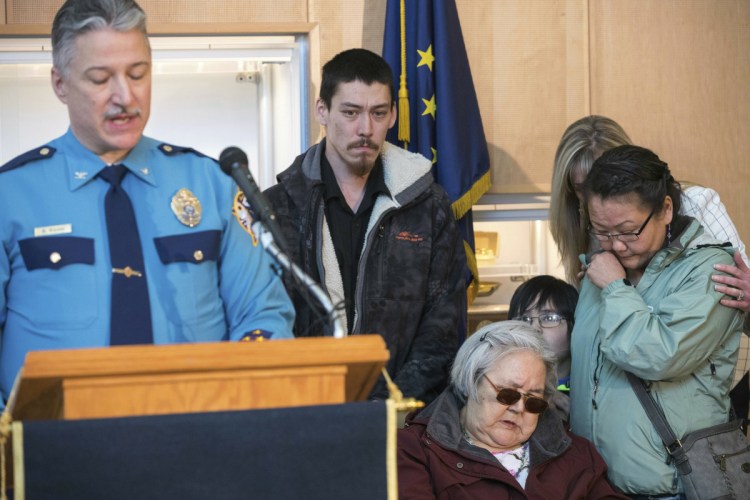Nearly 26 years ago, Steven H. Downs was just finishing his first year of college at the University of Alaska Fairbanks when a 20-year-old woman was brutally murdered there.
The Maine native lived on the third floor of Bartlett Hall – one floor above where Sophie Sergie, a Native Alaskan from Pitkas Point, was raped, repeatedly stabbed and shot in the back of the head in the girls bathroom.
At the time, the 18-year-old Downs and his roommate, a security guard working in the dorm, were briefly interviewed by investigators, but denied knowing anything about the sexual assault and murder. But on Friday, Downs, 44, was arrested in Auburn and charged with first degree murder and sexual assault in the case as the result of a breakthrough using DNA technology that helps people discover their genealogical roots.

Steven Downs Photo courtesy Androscoggin County Sheriff’s Department
That technology – which was also used to help authorities make an arrest last year in the Golden State Killer case in California – led Alaska State Troopers to Maine last week to make an arrest in the cold case.
A charging document filed Friday in District Court in Alaska reveals new details about how police homed in on Downs as a suspect. DNA voluntarily submitted by Downs’ aunt, coupled with traditional genealogical research, led investigators to Downs, who was living in Auburn and working as a nurse.
The biological evidence at the heart of the case was collected on April 26, 1993. The evidence included DNA as well as a bullet from a .22-caliber firearm. But a lack of technology to process the DNA did not immediately produce any breakthroughs.
In 2000, a more advanced type of DNA analysis was used. Spermatozoa was discovered and the killer was determined to be a male. A DNA profile was uploaded to the Combined DNA Identification System and compared to known profiles. No identical match was found, meaning that no male criminal offenders with DNA profiles matched the profile of the killer.
“As the years went by, additional suspects were explored and DNA samples were collected, but all potential suspects were eliminated as the source of the unidentified DNA,” Alaska Assistant Attorney General Paul Miovas Jr. wrote in the charging document. “By the end of 2003, the investigation had gone dormant.”
The next break in the case came in 2010. Investigator James Stogsdill, who had just been assigned the case, interviewed Nicholas Dazer, who worked as a security guard in the dorm where Sergie was killed. Dazer was working the night of the murder and had helped secure the scene in 1993.

Sophie Sergie, 1993
Stogsdill decided to reinterview Dazer, because he was ultimately fired from his job as a security guard for possessing a firearm, which was not permitted in the dorm. Dazer denied having a .22-caliber firearm, but told Stogsdill that his roommate, Steven H. Downs, had an H&R model .22-caliber revolver, among other firearms. But apparently that wasn’t enough for him to identify Downs as a “concrete subject,” Miovas wrote. And Stogsdill retired before the case was solved.
Fast-forward to 2018, when a new investigator, Randy McPherron, decided to contact a lab that uses genealogical databases to identify suspects in unsolved cases. Police already had the genetic blueprint of the suspect. But the genealogical database could help identify relatives of the suspect. And the lab ultimately identified two promising matches and three potentially promising matches.
After additional study, investigators believed they had found the aunt of the killer. “Through a thorough process of elimination, the lab determined that the known relative to the DNA profile only had one possible second-degree relationship, her nephew, Steven H. Downs.”
Further genealogical study traced Downs to Maine, where he was born and graduated from high school in 1992.
“Downs has no previous arrests, and his DNA has never been uploaded to the national database,” Miovas wrote. “Thus, the sample in the database from Sergie’s vaginal swab has never been previously compared to Downs’ DNA profile.”
Downs attended college in Fairbanks from 1992 to 1996. After living in Arizona for a period, he returned to Maine and was recently working as a nurse while living in Auburn, according to court records. Alaska State Troopers began working with Maine State Police and local police last week to devise a plan to contact Downs.
Downs told Alaskan and Maine investigators on Wednesday that he recalled Sergie’s murder but had never met her and didn’t know anything about it, according to the charging document. He also told police that he likely spent most of the night Sergie was killed in his girlfriend’s dorm room on the fourth floor of the same building.
According to court records, an autopsy revealed that Sergie was stabbed twice in the right corner of her right eye while she was still alive. She was killed by a single gunshot wound to the back of her head. And she was stabbed again in the face after she had died. Other abrasions and marks were found on her body, which was discovered in a bathtub about 12 hours after she was killed.
Court records indicate a female student was showering in the girls bathroom at around 1:30 a.m. She told investigators that she heard noises, such as thumping and muffled voices, coming from the tub room, which shared a wall with her shower stall.
On Thursday, investigators searched Downs’ residence at 132 Hillcrest St. in Auburn and obtained a DNA sample.
Within 24 hours, the Maine State Police Crime Lab processed the sample, which authorities now say points to Downs as the killer.
Downs was arrested without incident late Friday afternoon outside of the Fireside Inn on Washington Street in Auburn and is being held at the Androscoggin County Jail. He is expected to appear in court Tuesday and faces extradition to Alaska.
Comments are not available on this story.
Send questions/comments to the editors.



